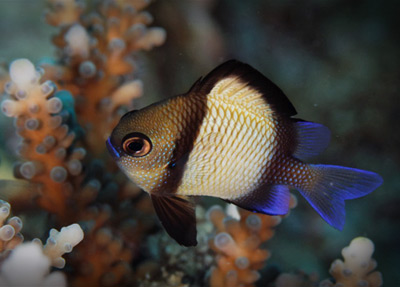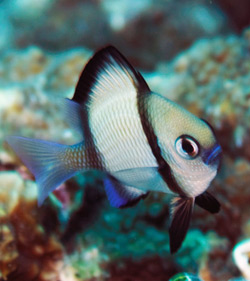Among the pomacentrids (damsels and clownfishes) are many species that rank exceptionally high when it comes to hardiness in aquaria (thus their once common use as tank cyclers) but also tend to mature into little hellions that can turn a peaceful community tank into an underwater war zone. The genus Dascyllus contains more than its fair share of these hardy-but-hostile damsels, including the subject of today’s profile: Dascyllus reticulatus, the two-stripe or reticulate damsel.
Though not chromatically gifted, D. reticulatus is striking in appearance nonetheless. Cute and peaceful as a juvenile, the two-stripe damsel can tempt hobbyists into making an impulse purchase only to discover later on that this Indo-Pacific pomacentrid is anything but passive. That aside, it can be a good candidate for a more rough-and-tumble community. You just have to keep that territorial belligerence foremost in mind when choosing a system and tankmates.
Physical traits
D. reticulatus is laterally compressed and somewhat disc-shaped, reaching a maximum size of around 3½ inches. Its coloration is variable, with the base color ranging from whitish to honey-brown. The scale margins are dark, creating a crosshatch pattern. As its common name implies, there are two dark stripes (ranging from brown to black) on its flanks, one just behind the gill flap, extending down along the leading edge of the pelvic fins, and the other just anterior to the caudal peduncle. The margin of the dorsal fin is also dark-colored. The head has a greenish hue, and the tail, anal fin, and posterior lobe of the dorsal fin are tinged with blue.
Feeding
This damsel is omnivorous and readily accepts all manner of small meaty and algae-based foods, including frozen and dry fare (such as New Life Spectrum Marine Fish Formula and AlgaeMAX). Several small offerings per day are recommended. Newly introduced specimens typically take to feeding with little or no reluctance.
Housing
D. reticulatus can be kept in tanks as small as 30 gallons, but keep in mind that it will be difficult in the extreme to keep any tankmates with it in an aquarium that size since it will claim the whole tank as its territory and attempt to drive all other fish away. Plus, fishes tough enough to stand up to this damsel tend to be way too large to fit in a 30-gallon system.
Compatibility
As you’ve probably guessed already, other damsels, including conspecifics (with the possible exception of established male-female pairs), can’t be recommended as tankmates for D. reticulatus. The same applies to any shy, docile heterospecifics. Suitable tankmates might include larger wrasses, angels, tangs, community-safe triggers, etc.—basically any fishes that are big and assertive enough to shrug off the damsel’s aggression but not inclined to make a meal of the damsel. But again, this type of community would necessitate a much, much larger system than the aforementioned 30-gallon.
Despite its hostile behavior toward other fishes, D. reticulatus is no threat to invertebrates and, therefore, makes an excellent reef aquarium candidate. In fact, one could argue that the safest way to keep this species—or any highly aggressive damsel, for that matter—is as the sole piscine occupant of a modest-sized reef system.




